‘2022’ Category
» posted on Saturday, September 3rd, 2022 by Linda Lou Burton
The Killer List
Linda Lou Burton posting from Little Rock, Arkansas – After that Deadly Mosquito, what animals in Africa are responsible for killing people every year? And how many? Not very many; the bigger Killer Story is the poaching of Africa’s animals by humans illegally dealing in ivory tusks and rhino horns. We aren’t allowed to wear cammies on safari, because that’s what the rangers on patrol wear on the reserves and conservancies set aside to protect the animals. Yes, they have guns, and dogs, and drones, and other high-tech resources to aid in the fight against poaching. I’ll be telling that story as our tour moves through our seven stops, guided safely and respectfully through the animals’ territory, taking photos, and taking notes. 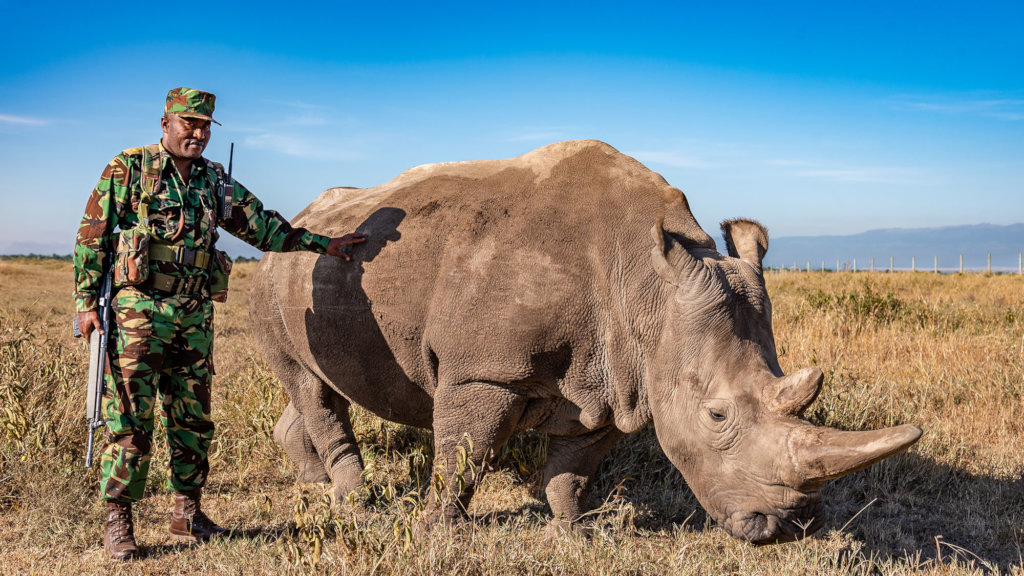
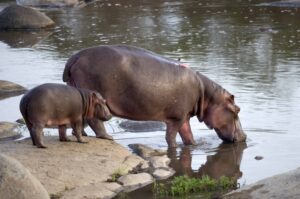 Hippopotamus: responsible for an estimated 3,000 deaths per year. Yes, the hippopotamus, that round-hipped critter that is often portrayed cartoon-like in a tutu, tops the Killer List. They don’t go looking for trouble, but male hippos fiercely defend their territories – which include the banks of rivers and lakes, while female hippos get extremely aggressive if they sense anything getting between them and their babies. Hippos are the third biggest animal in Africa, can run 30 mph, and have sharp half-meter teeth in enormous jaws. Suggestion: don’t put yourself between a hippo and its homeplace.
Hippopotamus: responsible for an estimated 3,000 deaths per year. Yes, the hippopotamus, that round-hipped critter that is often portrayed cartoon-like in a tutu, tops the Killer List. They don’t go looking for trouble, but male hippos fiercely defend their territories – which include the banks of rivers and lakes, while female hippos get extremely aggressive if they sense anything getting between them and their babies. Hippos are the third biggest animal in Africa, can run 30 mph, and have sharp half-meter teeth in enormous jaws. Suggestion: don’t put yourself between a hippo and its homeplace.
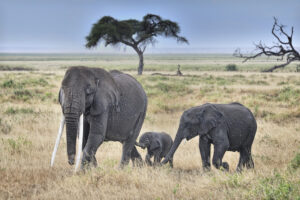 African Elephant: responsible for an estimated 500 deaths per year. We think of elephants as friendly fellows in circus parades, but remember, an elephant in its own territory feels, and is, responsible for its own well-being. Particularly where poaching occurs or habitat is in danger, older bull elephants, young males, and mothers with babies can be aggressive. They are herbivores, so don’t intend to rip you apart and eat you, they just want to stomp you to death if you bother their babies, or, in the case of those old bulls, disturb their peace. Suggestion: don’t do that.
African Elephant: responsible for an estimated 500 deaths per year. We think of elephants as friendly fellows in circus parades, but remember, an elephant in its own territory feels, and is, responsible for its own well-being. Particularly where poaching occurs or habitat is in danger, older bull elephants, young males, and mothers with babies can be aggressive. They are herbivores, so don’t intend to rip you apart and eat you, they just want to stomp you to death if you bother their babies, or, in the case of those old bulls, disturb their peace. Suggestion: don’t do that.
Nile Crocodile: responsible for an estimated 300 deaths per year. After while, crocodile is a cute expression, and it captures the approach a crocodile takes when making dinner plans. Known for their ambush hunting techniques, they are indiscriminate hunters and will attack any animal that comes within reach, including humans. Attacks on humans occur when people are washing close to riverbanks, or when fishermen get in or out of their boats. Those powerful jaws Clamp! Drag! Stash! Eat! Suggestion: don’t play in the mud.
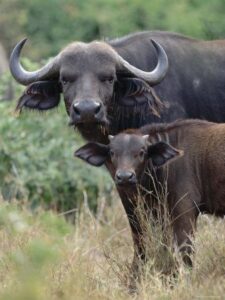 Cape Buffalo: responsible for an estimated 200 deaths per year. The Cape buffalo is sometimes referred to as ‘widow maker’ or ‘the black death.’ Group psychologists might say it’s the temper of the herd that drives the aggressiveness factor; they are fearless and will mob any predator that dares take its young. Big pointy horns, big bodies, trampling feet – they have no desire to snack on humans, but will come together in a mob if need be to protect each other. Suggestion: don’t rollerskate in a buffalo herd.
Cape Buffalo: responsible for an estimated 200 deaths per year. The Cape buffalo is sometimes referred to as ‘widow maker’ or ‘the black death.’ Group psychologists might say it’s the temper of the herd that drives the aggressiveness factor; they are fearless and will mob any predator that dares take its young. Big pointy horns, big bodies, trampling feet – they have no desire to snack on humans, but will come together in a mob if need be to protect each other. Suggestion: don’t rollerskate in a buffalo herd.
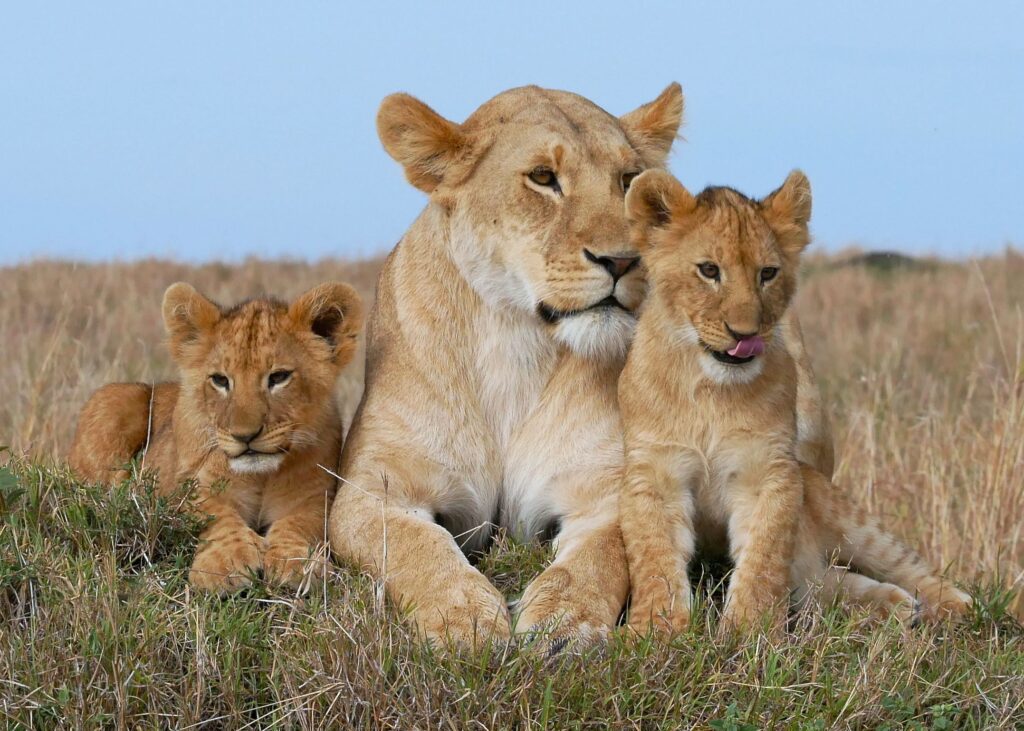 Lion: responsible for an estimated 200 deaths per year. Lions are predators, but they don’t naturally have a taste for humans, they’d much prefer a fresh antelope, zebra, or wildebeest. Those 200 human deaths in a year are generally caused by old sick lions, in areas where their natural prey has been depleted. Most attacks are on locals who eke out a living on the fringes of the game reserves. A sad end for the lions, and for the people. Suggestion: stop making the lion a bad guy.
Lion: responsible for an estimated 200 deaths per year. Lions are predators, but they don’t naturally have a taste for humans, they’d much prefer a fresh antelope, zebra, or wildebeest. Those 200 human deaths in a year are generally caused by old sick lions, in areas where their natural prey has been depleted. Most attacks are on locals who eke out a living on the fringes of the game reserves. A sad end for the lions, and for the people. Suggestion: stop making the lion a bad guy.
Last comment: An estimated 55 elephants a day are killed by poaching humans. Ponder that.
» posted on Friday, September 2nd, 2022 by Linda Lou Burton
What’s The Buzz?
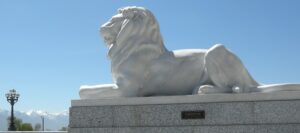 Linda Lou Burton posting from Little Rock, Arkansas – An African safari, these days, suggests being around animals. A lot of animals. Getting close. Which leads to good-natured kidding about becoming a “menu item,” with lions leading the suspect list. They do have big teeth, and sharp claws, and are so powerful we tend to place imposing lion statuary outside the doors of public buildings. Like, the New York Public Library, or the Utah State Capitol. Yet videos I’ve been watching recently of rigged-up Land Rovers on Game Drives in the Maasai Mara show lions ambling along beside the vehicles, or napping at the edge of the road while a hundred cameras are clicking.
Linda Lou Burton posting from Little Rock, Arkansas – An African safari, these days, suggests being around animals. A lot of animals. Getting close. Which leads to good-natured kidding about becoming a “menu item,” with lions leading the suspect list. They do have big teeth, and sharp claws, and are so powerful we tend to place imposing lion statuary outside the doors of public buildings. Like, the New York Public Library, or the Utah State Capitol. Yet videos I’ve been watching recently of rigged-up Land Rovers on Game Drives in the Maasai Mara show lions ambling along beside the vehicles, or napping at the edge of the road while a hundred cameras are clicking.
It made me wonder. “What IS the most dangerous animal in Africa?”
Answer: the mosquito.
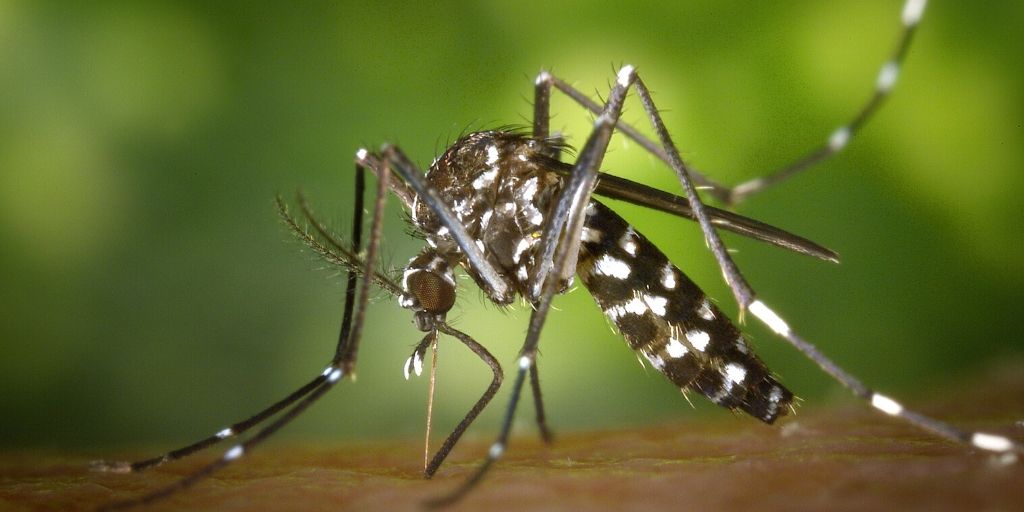 Mosquitoes are the deadliest animals on Earth, killing 725,000 people a year worldwide and sickening millions of others. According to World Health Organization estimates, the disease of malaria alone accounts for 600,000 of that number. The next most deadly animals are humans themselves (but we won’t go into that).
Mosquitoes are the deadliest animals on Earth, killing 725,000 people a year worldwide and sickening millions of others. According to World Health Organization estimates, the disease of malaria alone accounts for 600,000 of that number. The next most deadly animals are humans themselves (but we won’t go into that).
Malaria is particularly malicious and widespread; 200 million people are infected annually. Half the world’s population lives in areas that make them potential targets of opportunity for the malaria-carrying Anopheles mosquito looking for a blood meal.
From the Italian for “bad air,” malaria has been known about for 4,000 years. Hippocrates noted its symptoms in fourth-century Greece. It is thought to be responsible for the decline of the populations of many of the Greek city-states and the Roman Empire. Symptoms include high fevers, shaking chills, and flu-like illness. And unlike other mosquito-borne diseases, humans are part of the infection process. Malaria parasites grow and multiply first in the liver cells and then in the red blood cells, getting picked up by a feeding female mosquito, which then passes it on to yet another human.
Here are other deadly diseases that can result from a mosquito’s bloodsucking bite.
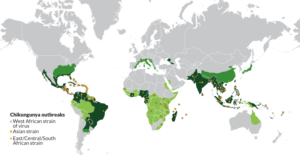 Chikungunya, primarily found in Africa, the Indian subcontinent and Asia; identified in 45 countries or territories in the Americas with more than 1.7 million suspected cases reported. It causes neurologic diseases such as Guillain-Barré syndrome, meningoencephalitis, cranial nerve palsies, rheumatic disorders. Dengue, primarily found in the tropics; an estimated 400 million dengue infections each year in over 125 countries; 40 percent of the world’s population live in dengue-risk areas. Symptoms: high fever, rash, severe headache, pain behind the eyes, muscle pain and joint pain so severe that dengue has been dubbed “breakbone fever.” Yellow Fever, characterized by fever, muscle pain, headache, nausea and vomiting — and, in rare cases, jaundice and bleeding from the mouth, nose, eyes and stomach. A vaccine is available, stemming occurrences in 99 percent of the people who take it. Still, it takes down 30,000 people each year. Zika is the marquee mosquito disease of the moment, found for the first time in the Western Hemisphere in 2015. Since this outbreak began, an estimated 500,000 to 1.5 million people have been infected. It doesn’t kill, but can cause a birth defect known as microcephaly, a condition that causes babies to be born with dangerously small heads and brain defects.
Chikungunya, primarily found in Africa, the Indian subcontinent and Asia; identified in 45 countries or territories in the Americas with more than 1.7 million suspected cases reported. It causes neurologic diseases such as Guillain-Barré syndrome, meningoencephalitis, cranial nerve palsies, rheumatic disorders. Dengue, primarily found in the tropics; an estimated 400 million dengue infections each year in over 125 countries; 40 percent of the world’s population live in dengue-risk areas. Symptoms: high fever, rash, severe headache, pain behind the eyes, muscle pain and joint pain so severe that dengue has been dubbed “breakbone fever.” Yellow Fever, characterized by fever, muscle pain, headache, nausea and vomiting — and, in rare cases, jaundice and bleeding from the mouth, nose, eyes and stomach. A vaccine is available, stemming occurrences in 99 percent of the people who take it. Still, it takes down 30,000 people each year. Zika is the marquee mosquito disease of the moment, found for the first time in the Western Hemisphere in 2015. Since this outbreak began, an estimated 500,000 to 1.5 million people have been infected. It doesn’t kill, but can cause a birth defect known as microcephaly, a condition that causes babies to be born with dangerously small heads and brain defects.
 I conclude: yes, the MOSQUITO is the thing most to be FEARED while we’re in Africa. We’ve got a full supply of MALARONE anti-malarial tablets to start taking before we leave and after we get home; we’ve got Maxi-Deet insect repellent and long sleeved shirts and long pants; friend Tracy gave me a permethrin-treated wrap-around scarf. We’re taking no dark clothing as dark colors attract mosquitos. All our camps and lodges have mosquito netting around the beds. (That “bell on the hiking boots” that scares away bears doesn’t work for mosquitos!) We have our internationally-recognized Yellow Book signed by the health authorities verifying that we’ve had the Yellow Fever vaccine.
I conclude: yes, the MOSQUITO is the thing most to be FEARED while we’re in Africa. We’ve got a full supply of MALARONE anti-malarial tablets to start taking before we leave and after we get home; we’ve got Maxi-Deet insect repellent and long sleeved shirts and long pants; friend Tracy gave me a permethrin-treated wrap-around scarf. We’re taking no dark clothing as dark colors attract mosquitos. All our camps and lodges have mosquito netting around the beds. (That “bell on the hiking boots” that scares away bears doesn’t work for mosquitos!) We have our internationally-recognized Yellow Book signed by the health authorities verifying that we’ve had the Yellow Fever vaccine.
But Bill Gates, bless his inventive soul, is on the warpath, going beyond HOW TO AVOID GETTING BIT, or PREVENTING ILLNESS AFTER BEING BIT.
Bill Gates is going after the MOSQUITO itself. You must go to his BLOG, and read about his incredible project, Mosquito Factory, where, inside a two-story brick building in Medellín, Colombia, a lab is breeding 30 million mosquitos a week. This is not science fiction!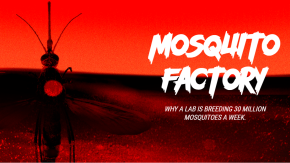
Sign up for Gates Notes, and read stories such as the one about Dr Matoke-Muhia that he tells: I know a lot of people who are driven to do something. When we were in high school, for example, Paul Allen and I would get quite absorbed in software projects—including neglecting sleep and showers. But that pales in comparison to the determination of Dr. Damaris Matoke-Muhia, a leader in the fight against malaria and other mosquito-borne diseases.
https://www.gatesnotes.com/Health/Mosquito-Week-2022
Tomorrow I’ll get back to Africa’s other Dangerous Animals, and see where the wrongly accused lion fits on the list.
» posted on Thursday, September 1st, 2022 by Linda Lou Burton
The Safari Experience According to Globus
Linda Lou Burton posting from Little Rock, Arkansas – Here’s the outline of where we’ll be going on our “17 days from Nairobi to Zanzibar” long-awaited safari trip, as described by the Globus marketing department. We’ve opted to stay in Zanzibar an extra day to relax on the beach, before heading to Iceland on our own. Are we ambitious, or what?
 Globus Says: “Africa conjures up dreamy images of mystical mountains, savanna grasslands, and endless plains, but for the adventure seeker, it’s where the wild things are. The “Big 5”—lion, leopard, elephant, rhino, and Cape buffalo await you on this ultimate safari through East Africa. Featuring unique lodges and tented camps, custom-made 4-wheel-drive safari vehicles, and exclusive meals in the bush, this Kenya and Tanzania tour promises larger than life experiences
Globus Says: “Africa conjures up dreamy images of mystical mountains, savanna grasslands, and endless plains, but for the adventure seeker, it’s where the wild things are. The “Big 5”—lion, leopard, elephant, rhino, and Cape buffalo await you on this ultimate safari through East Africa. Featuring unique lodges and tented camps, custom-made 4-wheel-drive safari vehicles, and exclusive meals in the bush, this Kenya and Tanzania tour promises larger than life experiences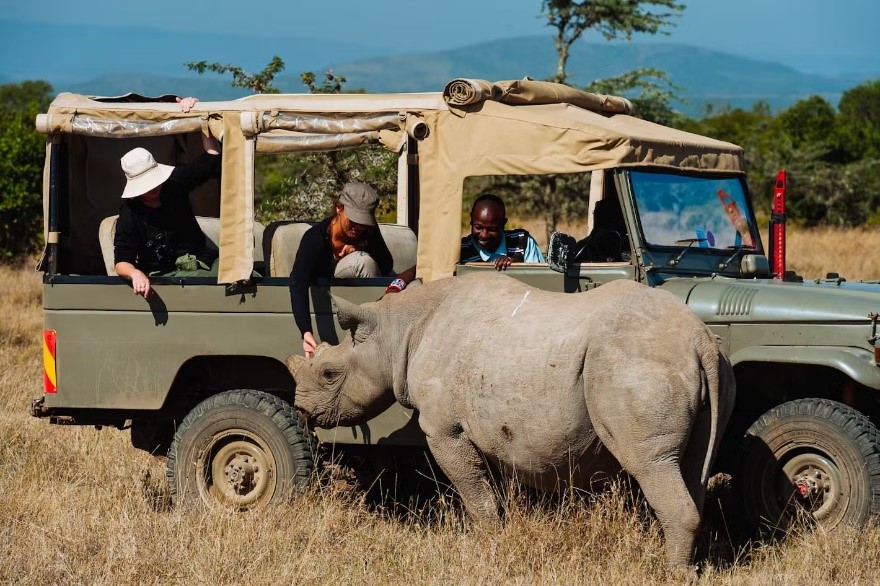 and countless memories. You’ll savor the unique terrain and wildlife at seven renowned national parks, reserves, and conservancies, including the famous Maasai Mara National Reserve, and the vast, volcanic Ngorongoro Conservation Area. Beyond sightings of the “Big 5,” be on the lookout for cheetah, wildebeest, crocodile, hippo, and rhino. On the tamer side, you’ll also enjoy a visit to the Sweetwaters Chimpanzee Sanctuary as well as the endearing experience of meeting the local children at a primary school in Karatu.
and countless memories. You’ll savor the unique terrain and wildlife at seven renowned national parks, reserves, and conservancies, including the famous Maasai Mara National Reserve, and the vast, volcanic Ngorongoro Conservation Area. Beyond sightings of the “Big 5,” be on the lookout for cheetah, wildebeest, crocodile, hippo, and rhino. On the tamer side, you’ll also enjoy a visit to the Sweetwaters Chimpanzee Sanctuary as well as the endearing experience of meeting the local children at a primary school in Karatu.
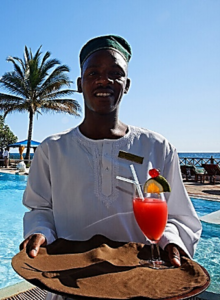 Explore more on your tour of Africa with Monograms packages to Nairobi and Zanzibar. In Nairobi, feed endangered giraffes at the Giraffe Center and meet orphaned elephant calves at the Sheldrick Wildlife Trust. Decelerate after an exhilarating vacation of game drives on a breezy, island getaway to Zanzibar. Move too fast and the hospitable locals will offer the gentle reminder, “Pole, pole!” meaning “Slowly, slowly!”
Explore more on your tour of Africa with Monograms packages to Nairobi and Zanzibar. In Nairobi, feed endangered giraffes at the Giraffe Center and meet orphaned elephant calves at the Sheldrick Wildlife Trust. Decelerate after an exhilarating vacation of game drives on a breezy, island getaway to Zanzibar. Move too fast and the hospitable locals will offer the gentle reminder, “Pole, pole!” meaning “Slowly, slowly!”
Each Globus Africa safari tour is limited to an average of just 20 guests per departure. There’s always room to roam with extra space between you and other travelers—while still getting up close and personal to the experiences you’ve been dreaming of. Small-Group Discoveries include all the features of a traditional Globus escorted tour, complete with expert Tour Director, Safari Guide/Driver, and Local Guides who ensure that your health and safety is our top priority.”
What do you think? What will we enjoy most? Will the mosquitos be as bad as we’ve been warned? Will the sunsets be as awesome? How many days in before we get tired? I’ll keep you posted.
If you’ve got the travel itch yourself after two years of COVID shutdown, check out the worldwide possibilities.
https://www.globusjourneys.com/
» posted on Wednesday, August 31st, 2022 by Linda Lou Burton
About Iceland
Linda Lou Burton posting from Little Rock, Arkansas – I know you’re wondering – why on earth would anyone go almost to the Arctic Circle after journeying to the Equator? There’s a good story behind it, which I’ll save for later. But top reason to go to Iceland is much the same reason for going to Africa: I’ve wanted to for a very, very long time. And since you have to go through Europe to get back to the US from Africa, what’s a few hours more flying time to hop a bit further north? Here are some things you need to know.
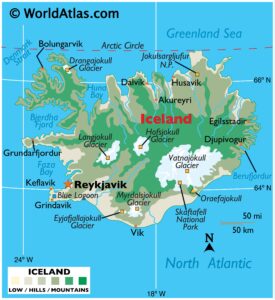 How big is Iceland? Where is it? What does it look like?
How big is Iceland? Where is it? What does it look like?
Iceland is about the size of the US state of Virginia. Technically a part of Europe, it is perched in the North Atlantic between Norway and Greenland, just brushing the Arctic Circle. It is the biggest part of the Mid-Atlantic Ridge that rises above sea level, and its central volcanic plateau erupts frequently. The interior consists of a plateau of sand and lava fields, mountains, and glaciers. Many rivers flow to the sea through the lowlands. Altogether a striking landscape of breathtaking waterfalls, bubbling geothermals, and rugged coastline.
How about Iceland’s weather?
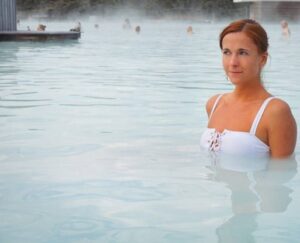 With a name that speaks of ICE, and a location not that far from the North Pole, Iceland has a surprisingly temperate climate. The Gulf Stream gets credit for that, plus the fact that Iceland sits atop a massive magma hot spot called the Iceland Plume. Outdoor swimming goes on year-round thanks to geothermal pools; houses are heated that way as well. Still, expect frequent weather changes in a day’s time; layer up. Last-day-of-August highs and lows: Little Rock 90-73; Reykjavik 53-44.
With a name that speaks of ICE, and a location not that far from the North Pole, Iceland has a surprisingly temperate climate. The Gulf Stream gets credit for that, plus the fact that Iceland sits atop a massive magma hot spot called the Iceland Plume. Outdoor swimming goes on year-round thanks to geothermal pools; houses are heated that way as well. Still, expect frequent weather changes in a day’s time; layer up. Last-day-of-August highs and lows: Little Rock 90-73; Reykjavik 53-44.
Who lives in Iceland?
Iceland’s people population last year was estimated at 376,248; 89% of that is of Icelandic heritage. Most Icelanders are descendants of Norse and Gaelic settlers. Icelandic, a North Germanic language, is descended from Old West Norse. Rather than using family names, as is the custom in most Western nations, Icelanders carry patronymic or matronymic surnames, and refer to one another by their given name. Patronymic last names are based on the first name of the father; matronymic names on the first name of the mother. These follow the person’s given name, e.g. Elísabet Jónsdóttir (“Elísabet, Jón’s daughter, ” Jón, being the father), or Ólafur Katrínarson (“Ólafur, Katrín’s son,” Katrín being the mother). 
As to the animal population, before humans settled in the 9th century, Iceland had only one land mammal, the Arctic fox. The rest of the creatures were either birds or marine animals. A millennium later, a wealth of life has adapted to the harsh climate, one of the most unique being the sturdy Icelandic horse, its bloodline so protected no imported horses are allowed. Sheep roam freely, reindeer too, but it’s the marine life that tops the list – whales, seals, dolphins, and 340 species of fish.
How does Iceland promote itself on its Visit Iceland site?
The coolest thing to see in Iceland today is a hot volcano. The Fagradalsfjall Volcano system awoke again on August 3, 2022, and is calm enough to sit close by and watch it spew and glow. Or you can go whale watching, berry picking, ice-cave exploring or simply sit on a tour bus and be driven from point to glorious point. Downtown Reykjavik is a walker’s paradise, plazas and parks and hop-on/hop-off buses. There are 266 museums in Iceland, 130 volcanoes, and an impressive array of restaurants. Seafood anyone?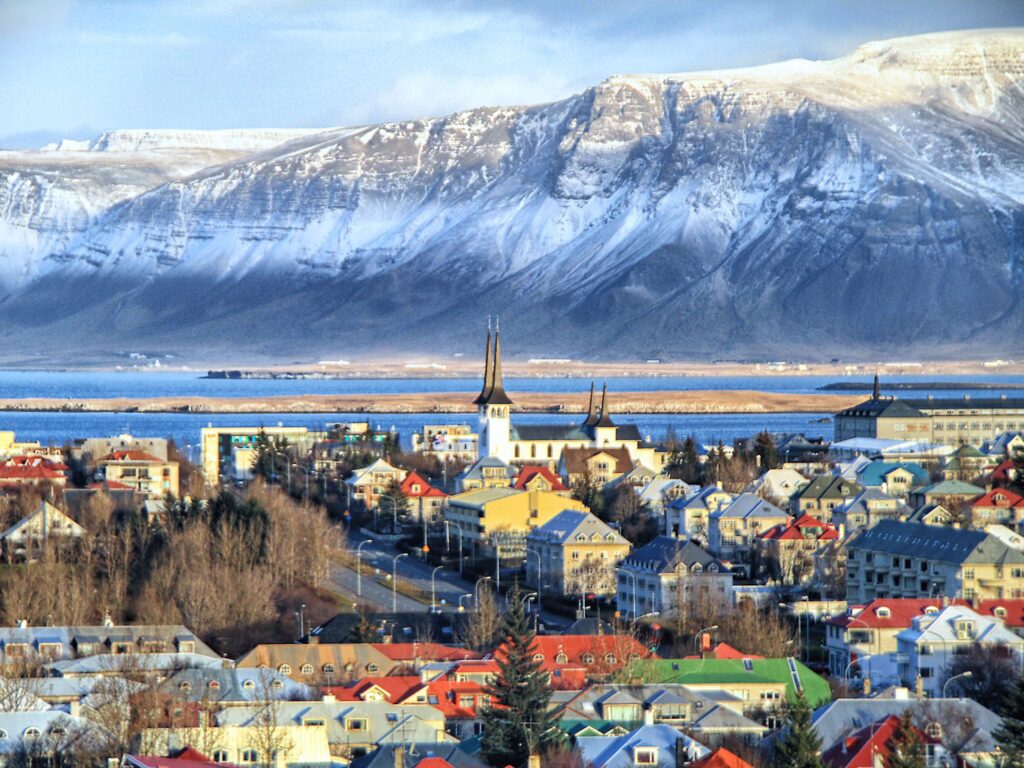
» posted on Tuesday, August 30th, 2022 by Linda Lou Burton
About Tanzania
Linda Lou Burton posting from Little Rock, Arkansas – After ten days in Kenya, with stops in Nairobi, Ol Pejeta Conservancy, Nakuru National Park, Maasai Mara National Reserve, and Amboseli National Park (where we’ll be peeking ahead at Mt Kilimanjaro!), we’ll cross the border into Tanzania. So what is the mystery of Tanzania? Here’s what I found.
 How big is Tanzania? Where is it? What does it look like?
How big is Tanzania? Where is it? What does it look like?
Tanzania is directly south of Kenya on Africa’s east coast, and for comparison to our US states, it’s bigger than Texas and almost as big as Alaska. Got that? Tanzania is mountainous and densely forested in the northeast, where 19,341-foot Mount Kilimanjaro, the highest point on the continent, is located. Three of Africa’s Great Lakes are partly within Tanzania. To the north and west lie Lake Victoria, Africa’s largest lake, and Lake Tanganyika, the continent’s deepest lake; to the south is Lake Malawi. The 885-mile Indian Ocean coastline is dotted with palm trees and white sands, with the Zanzibar Archipelago just off shore. Note Ngorongoro Crater there on the northern border!
How about Tanzania’s weather?
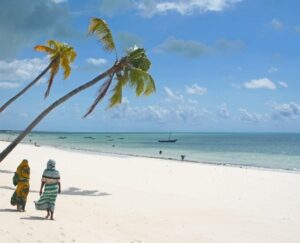 Climate varies greatly within Tanzania. It’s cool in the high mountainous regions, with temperatures ranging between 50-68 during cold and hot seasons respectively. The eastern shore is hot and humid. The rest of the country has temperatures rarely falling lower than 68. There are two major rainfall periods – October through December and March through May; as you might guess June through September are great times to visit for long sunny days!
Climate varies greatly within Tanzania. It’s cool in the high mountainous regions, with temperatures ranging between 50-68 during cold and hot seasons respectively. The eastern shore is hot and humid. The rest of the country has temperatures rarely falling lower than 68. There are two major rainfall periods – October through December and March through May; as you might guess June through September are great times to visit for long sunny days!
Tanzania’s people population is estimated at 56.3 million, composed of about 120 ethnic, linguistic, and religious groups. These ethnic groups are primarily of Bantu origin; the pastoral Maasai are perhaps the most familiar. 64% of Tanzanians are Christian; 34% Muslim. Over 100 different languages are spoken in Tanzania, making it the most linguistically diverse country in East Africa. About 10% of Tanzanians speak Swahili as a first language and up to 90% as a second. Unlike its neighboring countries, Tanzania has not experienced large-scale ethnic conflicts, perhaps due to the effects of Swahili as a unifying language. As to animal wildlife, Tanzania has the largest animal population density of any country in the world. There are more animals per square mile of land in Tanzania than anywhere else, with 430 mammal species and 1,112 bird species. About 20% of Africa’s large mammals live in Tanzania.
How does Tanzania promote itself?
About a third of the country’s total area is protected to a degree as a national park, game reserve, marine park, forest reserve or the like. The Tanzania Tourism Board and Tanzania Parks websites offers choices of Things to Do and Places to Go, with plenty of information about all those parks and reserves. About Serengeti: Serengeti National Park is undoubtedly the best-known wildlife sanctuary in the world, home to the greatest wildlife spectacle on earth – the great migration of wildebeest and zebra. The resident population of lion, cheetah, elephant, giraffe, and birds is also impressive. Serengeti won the TripAdvisor Travelers Choice Award in 2021, named as the Best of the Best National Park in the World.
https://www.tanzaniatourism.go.tz/en/
https://www.tanzaniaparks.go.tz/
» posted on Monday, August 29th, 2022 by Linda Lou Burton
About Kenya
Linda Lou Burton posting from Little Rock, Arkansas – Fast forward to 2022, and a notice from Globus Travels that they were “back in business with a bang” as COVID restrictions began to ease. So maybe THIS year I could spend a night on the rim of the Ngorongoro Crater? Maybe THIS year I could sit on Karen Blixen’s front porch in Nairobi? Heck yeah!
I found the Tour I wanted. I checked in with son Rick. Do you still want to go to Africa? Heck yeah! We picked a date, and paid the deposit to reserve our spot. Now that the “daydream” was at the least a possibility, I dug into my favorite hobby: research. The tour begins in Kenya, so that’s where I started. Look what I found!
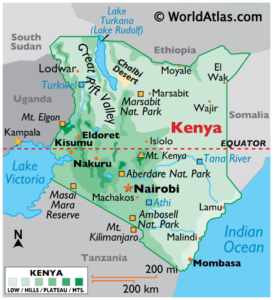 How big is Kenya? Where is it? What does it look like?
How big is Kenya? Where is it? What does it look like?
Kenya is an east African country roughly the size of the US state of Texas. Geographically diverse, the country rises from the shores of the Indian Ocean to the snow-capped peaks of 17,057-foot Mt Kenya. The Great Rift Valley takes a north-south route through the country, the Equator goes east-west through the middle. Lake Victoria, the world’s largest tropical lake, lies on the western border. The country is a mosaic of lion-gold savannah, rolling grassland, ancient rainforests, and volcanic plains.
How about Kenya’s weather?
Kenya has one of the most beautiful climates in the world, typically featuring long sunny days with clear blue skies, champagne-fresh air (especially up-country), golden evenings, and 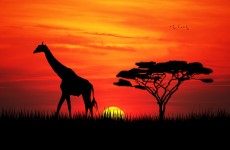 spectacular sunsets. Day and night are almost equal year round, with sunrise around 6 am and sunset around 6.30 pm. There is no summer/winter, rather rainy or dry seasons. The “long rains” occur from April to June; the “short rains” November to December. July and August are the coolest months; September through March the warmest. Note todays end-of-August highs/lows: Little Rock 92/70. Mombasa 83/70. Nairobi 72/59.
spectacular sunsets. Day and night are almost equal year round, with sunrise around 6 am and sunset around 6.30 pm. There is no summer/winter, rather rainy or dry seasons. The “long rains” occur from April to June; the “short rains” November to December. July and August are the coolest months; September through March the warmest. Note todays end-of-August highs/lows: Little Rock 92/70. Mombasa 83/70. Nairobi 72/59.
Who lives in Kenya?
Kenya’s 2021 people population was estimated at almost 55 million. There is a small ethnic minority of Arabs, Europeans, and Indians. The largest ethnic group is Kikuyu (8+ million); others of the many include Luhya, Luo, Somali, and Maasai (1+ million). 86% of Kenyans are Christian; 10% Muslim. The three largest cities are the capital, Nairobi (4.5 million), Mombasa (1.2 million) and Nakuru (580,000). As to animal wildlife, over 100 mammals and 400 species of birds live in Kenya. 238 animals are tracked regularly, and reports show 36,280 elephants, 29,200 giraffes, and 5,200 buffalo lead the ranks. The lion, Kenya’s national animal, has a population of approximately 2,500. 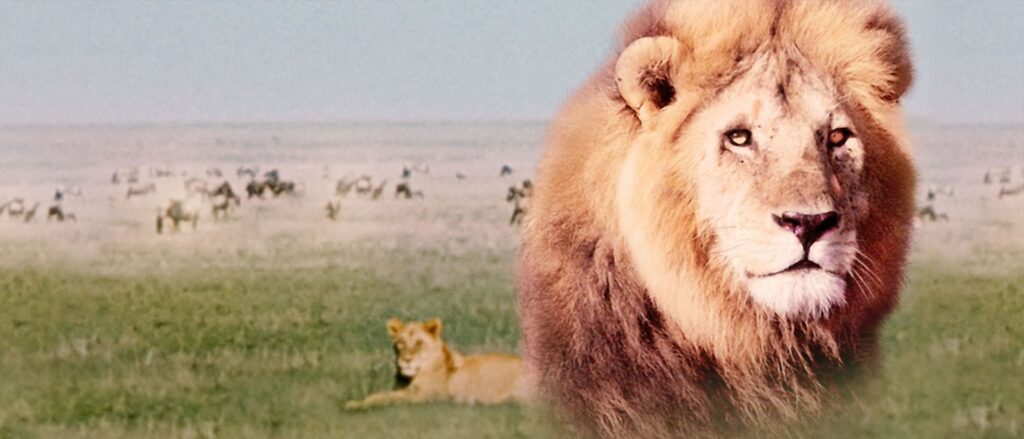
How does Kenya promote itself on its site, Magical Kenya?
Iconic Safaris is one of the choices of Things to Do in the Nature & Wildlife category. Since we’ll be going On Safari, I clicked that link.
Kenya is the classic African safari destination, with over 45 national parks, reserves, sanctuaries, and over 100 conservancies. Home to unique and diverse wildlife, Kenya offers incredible natural beauty and sensational game viewing opportunities. Discover and explore the magnificent wildlife in many ways – walking, a hot air balloon ride, horseback, game viewing vehicles, or simply from the comfort of your lodge/camp.
Check it out. Especially the video. Elephants! Rhinos! Land Rovers!
Other categories: Culture & Heritage. Adventure & Sports. Beach & Beyond.
https://magicalkenya.com/things-to-do/nature-wildlife/iconic-safaris/
» posted on Sunday, August 28th, 2022 by Linda Lou Burton
Traveling Companionably
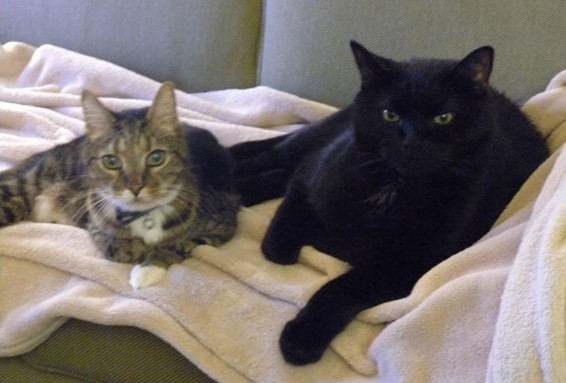 Linda Lou Burton posting from Little Rock, Arkansas – I’ve traveled a lot with my cats, Alex and Jack. John Steinbeck traveled with his French poodle, Charley. Mark Twain traveled with various folks in his lifetime, firm in his belief that “travel is fatal to prejudice, bigotry, and narrow-mindedness, and many of our people need it sorely on these accounts. Broad, wholesome, charitable views of men and things cannot be acquired by vegetating in one little corner of the earth all one’s lifetime.”
Linda Lou Burton posting from Little Rock, Arkansas – I’ve traveled a lot with my cats, Alex and Jack. John Steinbeck traveled with his French poodle, Charley. Mark Twain traveled with various folks in his lifetime, firm in his belief that “travel is fatal to prejudice, bigotry, and narrow-mindedness, and many of our people need it sorely on these accounts. Broad, wholesome, charitable views of men and things cannot be acquired by vegetating in one little corner of the earth all one’s lifetime.”
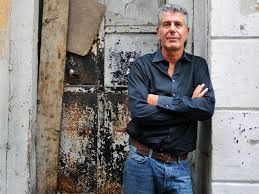 Anthony Bourdain is the kind of companion I would choose to travel with; my favorite traveler of all time. What he has done, and seen, and filmed, and written about is out there for all to see; his gritty, unflinching view of the world as it is, and his insistence on telling the truth about it. And he saw travel as a two-way ride; “travel changes you,” he said. “As you move through this life and this world you change things slightly, you leave marks behind, however small. And in return, life – and travel – leaves marks on you.”
Anthony Bourdain is the kind of companion I would choose to travel with; my favorite traveler of all time. What he has done, and seen, and filmed, and written about is out there for all to see; his gritty, unflinching view of the world as it is, and his insistence on telling the truth about it. And he saw travel as a two-way ride; “travel changes you,” he said. “As you move through this life and this world you change things slightly, you leave marks behind, however small. And in return, life – and travel – leaves marks on you.”
As I began considering a visit to Africa some years ago, I thought about how such a trip would change me, and, of what kind of companion might approach this venture with attitudes similar to mine. Most people I knew had no desire to go to Africa! I had friends who had been; one on a mission to change things there; a few on a mission to climb a mountain; a few daring to race across the desert. I wanted to go to experience Africa, to meet people who live there, and to go away understanding the world a little bit better.
So I made a list, and whittled it down.
- 1st off the list – the Comparer! You know what I mean: “We don’t do things THAT way where I live!” “MY family always did it THIS way!”
- # 2 – the Whiner. “It’s too hot. It’s too noisy. It’s too far. It stinks! I’m tired!”
- # 3 – the Scaredy-Cat. “I’m not eating THAT! I can’t climb THAT! I’m not getting MY feet wet!”
- # 4 – the Bore. Droning on all day about nothing.
- # 5 – the Rigid. It’s got to be their way. Precise. No changes. No spontaneity! Point A straight to Point B, no stops, even to pee!
- # 6 – the Conjoined Twin. Connected to your hip. You can’t make a move without them, and they want to drag you everywhere they go.
- # 7 – the Humorless. Absolutely nothing is fun, or funny. No smiles.
- # 8 – the Blatantly Insensitive. Sneery nose up at anything different. No respect for others, their customs, or their way of life.
- # 9 – the Martyr. Jumps around to “caregive” instead of allowing others to do what they can.
- #10 – the Short Fuse. Blam!
 An easygoing manner, a good sense of humor, and a taste for adventure top the “desirables” list. A willingness to try something new. A relentless curiosity. A Bourdain! I asked my retired son Rick (who had long expressed an interest in Italy) if he had a choice, where would he want to go – Africa, Europe, or Asia? He didn’t hesitate – “Well, Africa! Anybody can go to Europe. A trip to Africa would be the trip of a lifetime.”
An easygoing manner, a good sense of humor, and a taste for adventure top the “desirables” list. A willingness to try something new. A relentless curiosity. A Bourdain! I asked my retired son Rick (who had long expressed an interest in Italy) if he had a choice, where would he want to go – Africa, Europe, or Asia? He didn’t hesitate – “Well, Africa! Anybody can go to Europe. A trip to Africa would be the trip of a lifetime.”
Next step completed: my Africa travel companion chosen. Now, the planning. And the wait through the COVID years.
» posted on Saturday, August 27th, 2022 by Linda Lou Burton
That Farm in Africa
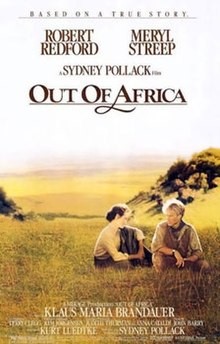 Linda Lou Burton posting from Little Rock, Arkansas – The second thing that has me longing to go Africa is due to a woman named Karen, who “had a farm in Africa.” It was Karen Blixen, pen name Isak Dinesen, who wrote “Out of Africa.” It was Meryl Streep’s lovely sing-song recitation of the first line of that book that stuck with me from the 1980’s, when she and Robert Redford made the movie of the same name.
Linda Lou Burton posting from Little Rock, Arkansas – The second thing that has me longing to go Africa is due to a woman named Karen, who “had a farm in Africa.” It was Karen Blixen, pen name Isak Dinesen, who wrote “Out of Africa.” It was Meryl Streep’s lovely sing-song recitation of the first line of that book that stuck with me from the 1980’s, when she and Robert Redford made the movie of the same name.
It was not until I actually read the book however, that I began to get a real sense of the magic of east Africa. Sydney Pollack turned Karen’s “love story” into a relationship with a good-looking English hunk. Yes, there were magnificent scenes of Kenyan scenery, and episodes of bravery, and tenderness, and the awful tragedy of losing both her lover and her farm. But that’s not the full story of the Karen Blixen to be found as penned by her own hand; though she was born in Denmark, Africa was the home of her heart. Her book, written in 1937 a few years after she was forced to leave, begins like this:
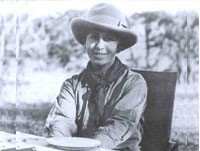 I had a farm in Africa, at the foot of the Ngong Hills. The Equator runs across these highlands, a hundred miles to the North, and the farm lay at an altitude of over six thousand feet. In the day-time you felt that you had got high up, near to the sun, but the early mornings and evenings were limpid and restful, and the nights were cold…The geographical position, and the height of the land combined to create a landscape that had not its like in all the world. There was no fat on it, and no luxuriance anywhere; it was Africa distilled up through six thousand feet, like the strong and refined essence of a continent. The views were immensely wide. Everything you saw made for greatness and freedom, and unequalled nobility…Up in this high air you breathed easily, drawing in a vital assurance and lightness of heart. In the highlands you woke up in the morning and thought: Here I am, where I ought to be.
I had a farm in Africa, at the foot of the Ngong Hills. The Equator runs across these highlands, a hundred miles to the North, and the farm lay at an altitude of over six thousand feet. In the day-time you felt that you had got high up, near to the sun, but the early mornings and evenings were limpid and restful, and the nights were cold…The geographical position, and the height of the land combined to create a landscape that had not its like in all the world. There was no fat on it, and no luxuriance anywhere; it was Africa distilled up through six thousand feet, like the strong and refined essence of a continent. The views were immensely wide. Everything you saw made for greatness and freedom, and unequalled nobility…Up in this high air you breathed easily, drawing in a vital assurance and lightness of heart. In the highlands you woke up in the morning and thought: Here I am, where I ought to be.
Dinesen, Isak. Out of Africa and Shadows on the Grass. New York: Vintage International, 1988, pp 3-4.
Why do I want to go to Africa? I want to see THAT place. I want to sit on Karen’s front porch, looking across that broad lawn where her people, the Kikuyu squatters and the Somali servants who helped to run the farm; who picked the coffee and cared for the house, but most of all, who were a central part of her daily life – gathered every day. Her connection with the people of Africa is the real story.
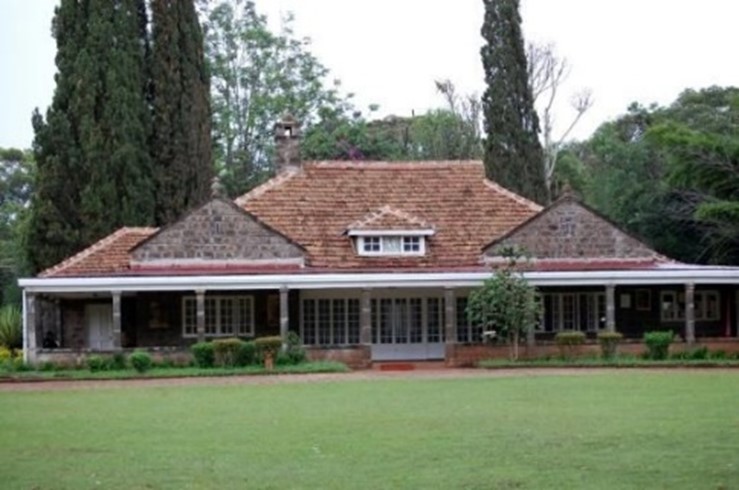 When Karen lost her farm and returned to Denmark in 1931, her property was sold as large parcels for homes; the suburb that emerged is now called “Karen.” The original farmhouse changed hands several times, for a time housing a college; it was turned into a museum after the movie came out. Many of Karen’s original furnishings have been restored, and tours are offered continuously every day between 9:30 – 6.
When Karen lost her farm and returned to Denmark in 1931, her property was sold as large parcels for homes; the suburb that emerged is now called “Karen.” The original farmhouse changed hands several times, for a time housing a college; it was turned into a museum after the movie came out. Many of Karen’s original furnishings have been restored, and tours are offered continuously every day between 9:30 – 6.
I’ll be there soon.
Karen Blixen Museum, Nairobi, Kenya
» posted on Friday, August 26th, 2022 by Linda Lou Burton
On The Crater’s Rim
Linda Lou Burton posting from Little Rock, Arkansas — It started with a hotel. Being a Holiday Inn-Best Western-LaQuinta aficionado from years of budget travel with my kids, and later, my cats, I viewed “overnight accommodations” as being handy places to pull off the highway come evening, get a bath, and sleep. A cinnamon bun and coffee in the breakfast area the next day got me back on the road quickly.
One day, studying “places I’d like to go someday” I stumbled across a safari tour to Africa, with a stop at the Ngorongoro Serena Safari Lodge, described in words that struck like magic:
Regularly voted one of the best hotels in the world, this unique lodge clings to the rim of the magnificent Ngorongoro Crater, the largest and most perfect volcanic crater on Earth. Long and low, the lodge is built from local river stone and camouflaged with indigenous vines. Designed to blend completely into the landscape, it is entirely invisible from the floor of the Crater 600 meters below. Hugging the contours of the jagged Crater rim, the lodge takes its inspiration from the so-called “Cradle of Mankind,” the prehistoric site of Olduvai Gorge, which lies close by. Linked by arched stone passages and timbered decks, its walls are decorated with stylized prehistoric cave paintings and lit by flaring torches.
This of course sent me on a reading binge about the Ngorongoro Crater, as well as a pronunciation guide. (uhng gr raang gr ow)
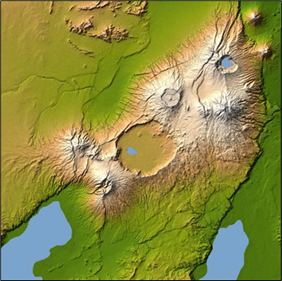 Ngorongoro Crater is the world’s largest inactive, intact and unfilled volcanic caldera. The crater, which formed when a large volcano exploded and collapsed on itself two to three million years ago, is 2,000 feet deep and its floor covers 100 square miles. Estimates of the height of the original volcano range from 14,800 to 19,000 feet The crater floor is 5,900 feet above sea level. The crater was voted one of the Seven Natural Wonders of Africa and is a UNESCO World Heritage Site known as the Eighth Wonder of the World. Deep within its immense walls is a breath-taking blue-green landscape dotted with plains, lakes and forests; an eerie, otherworldly “land that time forgot” thick with massive bull elephants, rhinos, wildebeests and the highest concentration of lions in Africa.
Ngorongoro Crater is the world’s largest inactive, intact and unfilled volcanic caldera. The crater, which formed when a large volcano exploded and collapsed on itself two to three million years ago, is 2,000 feet deep and its floor covers 100 square miles. Estimates of the height of the original volcano range from 14,800 to 19,000 feet The crater floor is 5,900 feet above sea level. The crater was voted one of the Seven Natural Wonders of Africa and is a UNESCO World Heritage Site known as the Eighth Wonder of the World. Deep within its immense walls is a breath-taking blue-green landscape dotted with plains, lakes and forests; an eerie, otherworldly “land that time forgot” thick with massive bull elephants, rhinos, wildebeests and the highest concentration of lions in Africa.
Next question was: How do I get there, and when can I go? This wasn’t just something, this was REALLY something!
It reminded me of the planning of my trip to Antarctica. I knew the where, and the when I wanted to do it, last question was the HOW? As part of a research team studying penguins (not possible), as crew on a Russian fishing ship (not desirable), or on a small cruise ship, and, which one of those?
I quickly found there are many “safari” tours hauling folks around the most alluring spots in Africa – those that promise sightings of “the big 5” or treks in gorilla country; those headed to shimmering deserts or mountain-top lakes or rivers surging with crocodiles; all offering opportunities to go rugged, or go luxury. Which would be the best “fit” for me?
The Globus Tours site offered a reasonable package– start in Nairobi, visit four camps in Kenya, then three in Tanzania – location of that fabulous hotel overlooking that other-worldly crater – and then end the trip with beach time in Zanzibar. What year could this reasonably happen?
 Next step: enlist a fellow day dreamer to help believe it into reality. I pinned pictures of that hotel, and that crater, in easy view, to nudge me on.
Next step: enlist a fellow day dreamer to help believe it into reality. I pinned pictures of that hotel, and that crater, in easy view, to nudge me on.
Link to Ngorongoro Serena Safari Lodge
https://www.serenahotels.com/ngorongoro
» posted on Thursday, August 25th, 2022 by Linda Lou Burton
Dragging George
 Linda Lou Burton posting from Little Rock, Arkansas – Have you heard the one about Bob and George, two best friends? These guys had been golfing fanatics since their college days, and now, retired and in their 70’s, devoted themselves to the game.
Linda Lou Burton posting from Little Rock, Arkansas – Have you heard the one about Bob and George, two best friends? These guys had been golfing fanatics since their college days, and now, retired and in their 70’s, devoted themselves to the game.
They belonged to the Happy Valley Country Club, and every day had a standing date for a slow-paced 18 holes, and drinks on the patio afterwards to discuss every shot. On one particular fine spring day, it was mid-April I believe, Bob didn’t get home till almost dark; his wife Lucinda was getting worried.
She ran to the door when she heard his car in the drive, and watched as Bob slowly exited, shoulders hunched, head down.
“What’s wrong?” was her question. “Are you okay?”
“George is dead,” Bob blurted out.
Lucinda put her arms around her husband, exclaiming “Oh you poor dear! Your very best friend has died! What in the world happened?”
“George had a heart attack.” Bob said, shaking his head. “He just dropped dead on the spot!”
Lucinda guided Bob over to his favorite easy chair. “Sit down and rest sweetheart, and tell me all about it. You look awful!”
“Oh, I am exhausted,” Bob replied. “We were on Tee Box #4 when it happened, and all day long it’s been nothing but hit the ball and drag George.”
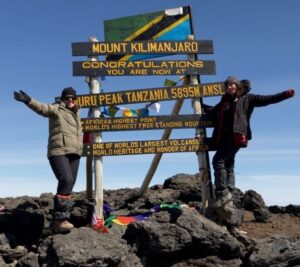 I have some friends who climbed Africa’s Mt Kilimanjaro a few years ago. Can you imagine what is involved in preparing for a trip like that? The training – for a year at least; to get you strong enough and lean enough and tough enough to BELIEVE you can keep going up and up and up for 19,341 feet where the altitude is unkind to your gut and lungs and you have to keep monitoring the oxygen level in your blood? The organizational details of such a trip to another country boggle the mind: vaccinations, medications, equipment, scheduling. Which guide service to use? Which route is best? Which time of year will the weather be good, so we summit at the EXACT PERFECT MOMENT for a sunrise?
I have some friends who climbed Africa’s Mt Kilimanjaro a few years ago. Can you imagine what is involved in preparing for a trip like that? The training – for a year at least; to get you strong enough and lean enough and tough enough to BELIEVE you can keep going up and up and up for 19,341 feet where the altitude is unkind to your gut and lungs and you have to keep monitoring the oxygen level in your blood? The organizational details of such a trip to another country boggle the mind: vaccinations, medications, equipment, scheduling. Which guide service to use? Which route is best? Which time of year will the weather be good, so we summit at the EXACT PERFECT MOMENT for a sunrise?
What did the two agree between themselves? A sacred thing: if I can’t make it, you keep going.
I had another friend who organized a team to climb Mt Aconcagua, at 22,837 feet the tallest mountain in South America. There were 12 in the party, and after a year’s hard training, they finally arrived in South America, each with mounds of climbing equipment and supplies. (Kilimanjaro is a seriously rugged walk, but Aconcagua is a technical ice climb requiring much more equipment.) First they traveled two days by train from the airport to the starting point. From there, it was four days by pack mule to the place to begin the ascent. Each person’s name was called as their equipment was removed from the pack mules, but alas, ONE BAG of essential technical equipment for ONE PERSON had been left at the train station. Due to weather conditions and schedules for other climbers, the group could not wait the time it would take to retrieve it. And the unlucky fellow could not make the climb without his equipment.
 The sacred agreement: if I can’t make it, you keep going.
The sacred agreement: if I can’t make it, you keep going.
Dragging George is a golfer’s joke, of course. But helping another reach their goal by finishing the course when they can’t make it – well, that is a pretty nifty thing.
I’m planning a trip to Africa, and, for a grand finale, to Iceland. It all began five years ago….

